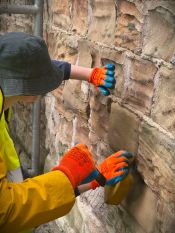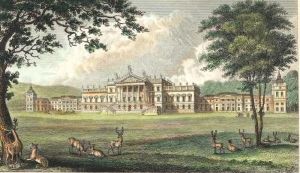Paint Stripping Samples for Wythenshaw Hall
Womersley’s have been employed to undertake sample paint stripping to the fire damaged main hall at Wythenshawe Hall. The ornate plasterwork ceiling was damaged by a fire, on the 15th March 2016. Scheidel paint strippers have proved effective at removing both charred acrylic based paints and earlier plant oil based finishes below.
There are a number of processes for removing paint from walls and ceilings but on this job with fire damaged plaster it was essential to find a method to get back to an appropriate surface using the least damaging method available with minimal risk to the operator and surroundings.
Mechanical cleaning and mechanical abrasion would damage the ornate and sensitive plaster work and steam cleaning may further damage gypsum plaster already suffering some calcination following the fire and subsequent saturating with fire hose water.
Chemical solutions based on dissolving the paint with the use of chemical formulations can be a very effective method for removal without damaging the substrate. However there have been widespread concerns around the world in recent years regarding the cocktail of chemicals used within the differing products. Such concerns resulted in the European Union banning the use of DCM’s (Di-Chloromethane) in products sold to the public. *DCM has been classified as a Category 3 carcinogen in the European Community.
Womersleys used and supply an extensive range of DCM free paint strippers produced by Scheidel one of Germany’s leading manufacturers in this field, who have been producing DCM free paint stripping products since the late 1960’s.

There are many types of chemical stripper with the more aggressive potions sometimes acting instantaneously while others such as the Scheidel range, applied as a poultice, pasted onto the surface breaking down the paints binders facilitating later removal by scraper or water cleaning, normally after 24 hrs.

The most successful samples were stripped with a combination of Asur and SG94. Both products are CHC-free (chlorinated hydrocarbon) and work on the basis of slowly exhaling esters and other special solvents that break down the paints binders. Once the paint coatings were removed the surfaces were washed with Powerfluid and water and rinsed clean with water. Powerfluid is a detergent cleaner used after paint removal to help neutralise the chemicals.

The Hall, a grade II* listed building, is a 16th-century medieval timber-framed historic house and former manor house in Wythenshawe, Manchester. It was built around 1540 by Robert Tatton of Chester. The timber-framed Tudor house was the home of the family for almost 400 years.

The timber-framed manor house consisting of a hall with two projecting wings, and a porch and dais bays, was partially rebuilt between 1795 and 1800 by Lewis Wyatt. It was again altered around 1840 possibly by Edward Blore. Additions included a walled garden, an ice house, and glass houses. In the Victorian era the dining room was refurbished and a tenant's hall was added.
By April 1926, Wythenshawe Hall and 250 acres (1 km2) of its surrounding parkland were sold to Ernest Simon and his wife who donated them to Manchester Corporation "to be used solely for the public good". In 1930, the hall was turned into a museum and art gallery.
Related Articles

The steps members of the Waterton’s Wall restoration team, with support from Mark Womersley, have been following to consolidate, conserve and repair this historic wall that represents the successful efforts of Charles Waterton to preserve the wildlife that lived on his estate near Wakefield in West Yorkshire.
1. Fill deep voids behind the wall’s facing stones with deep pointing work. The works involve …

Mark spent a day recording a historic timber-framed garden building at Woodsome Hall
Mark Womersley, as part of his voluntary work with the Yorkshire Vernacular Buildings Study Group, spent…

M Womersleys were delighted to offer a day of tutoring to those who attended the Wentworth Woodhouse Working Party
M Womersleys were delighted to offer a day of tutoring to those who attended the Wentworth Woodhouse…